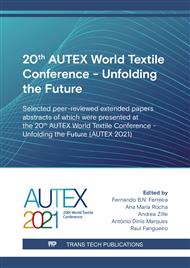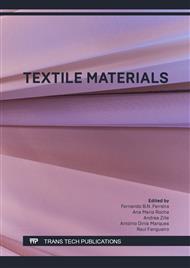[1]
J. Wendler, A. Nocke, D. Aibibu, C. Cherif, Novel temperature sensors based on strain-relieved braiding constructions, Textile Research Journal 5 (2018) 004051751880744.
DOI: 10.1177/0040517518807445
Google Scholar
[2]
I. Jerkovic, V. Koncar, A.M. Grancaric, New Textile Sensors for In Situ Structural Health Monitoring of Textile Reinforced Thermoplastic Composites Based on the Conductive Poly(3,4-ethylenedioxythiophene)-poly(styrenesulfonate) Polymer Complex, Sensors (Basel, Switzerland) 17 (2017).
DOI: 10.3390/s17102297
Google Scholar
[3]
W.A. Hufenbach, P. Kostka, B. Maron, D. Weck, J. Ehlig, M. Gude, M. Zscheyge, Development and Investigation of a Textile-reinforced Thermoplastic Leaf Spring with Integrated Sensor Networks, Procedia Materials Science 2 (2013) 173–180.
DOI: 10.1016/j.mspro.2013.02.021
Google Scholar
[4]
A. Nocke, A. Schröter, C. Cherif, G. Gerlach, Miniaturized textile-based multi-layer ph-sensor for wound monitoring applications, Autex Research Journal 12 (2012) 20–22.
DOI: 10.2478/v10304-012-0004-x
Google Scholar
[5]
P. Lugoda, T. Hughes-Riley, R. Morris, T. Dias, A Wearable Textile Thermograph, Sensors (Basel, Switzerland) 18 (2018).
DOI: 10.3390/s18072369
Google Scholar
[6]
E. Haentzsche, T. Onggar, A. Nocke, R.D. Hund, C. Cherif, Multi-layered sensor yarns for in situ monitoring of textile reinforced composites, IOP Conf. Ser.: Mater. Sci. Eng. 254 (2017) 42012.
DOI: 10.1088/1757-899x/254/4/042012
Google Scholar
[7]
K. Bremer, F. Weigand, Y. Zheng, L.S. Alwis, R. Helbig, B. Roth, Structural Health Monitoring Using Textile Reinforcement Structures with Integrated Optical Fiber Sensors, Sensors (Basel, Switzerland) 17 (2017).
DOI: 10.3390/s17020345
Google Scholar
[8]
J.S. Heo, J. Eom, Y.-H. Kim, S.K. Park, Recent Progress of Textile-Based Wearable Electronics: A Comprehensive Review of Materials, Devices, and Applications, Small (Weinheim an der Bergstrasse, Germany) 14 (2018).
DOI: 10.1002/smll.201703034
Google Scholar
[9]
B. Wang, A. Facchetti, Mechanically Flexible Conductors for Stretchable and Wearable E-Skin and E-Textile Devices, Advanced materials (Deerfield Beach, Fla.) 31 (2019) e1901408.
DOI: 10.1002/adma.201901408
Google Scholar
[10]
V. Koncar (Ed.), Smart Textiles and their Applications, Woodhead Publishing, Oxford, (2016).
Google Scholar
[11]
R.R. Ruckdashel, D. Venkataraman, J.H. Park, Smart textiles: A toolkit to fashion the future, Journal of Applied Physics 129 (2021) 130903.
DOI: 10.1063/5.0024006
Google Scholar
[12]
A. Issatayeva, A. Beisenova, D. Tosi, C. Molardi, Fiber-Optic Based Smart Textiles for Real-Time Monitoring of Breathing Rate, Sensors (Basel, Switzerland) 20 (2020).
DOI: 10.3390/s20123408
Google Scholar
[13]
E.-F.M. Henke, S. Schlatter, I.A. Anderson, Soft Dielectric Elastomer Oscillators Driving Bioinspired Robots, Soft robotics 4 (2017) 353–366.
DOI: 10.1089/soro.2017.0022
Google Scholar
[14]
D. Rus, M.T. Tolley, Design, fabrication and control of soft robots, Nature 521 (2015) 467–475.
DOI: 10.1038/nature14543
Google Scholar
[15]
A. Satharasinghe, T. Hughes-Riley, T. Dias, Photodiode and LED embedded textiles for waerable healthcare applications, Ghent, (2019).
Google Scholar
[16]
E. Haentzsche, R. Mueller, M. Huebner, T. Ruder, R. Unger, A. Nocke, C. Cherif, Manufacturing technology of integrated textile-based sensor networks for in situ monitoring applications of composite wind turbine blades, Smart Mater. Struct. 25 (2016) 105012.
DOI: 10.1088/0964-1726/25/10/105012
Google Scholar
[17]
T. Onggar, G. Amrhein, A. Abdkader, R.-D. Hund, C. Cherif, Wet-chemical method for the metallization of a para-aramid filament yarn wound on a cylindrical dyeing package, Textile Research Journal 87 (2017) 1192–1202.
DOI: 10.1177/0040517516651099
Google Scholar
[18]
S. Qin, S. Seyedin, J. Zhang, Z. Wang, F. Yang, Y. Liu, J. Chen, J.M. Razal, Elastic Fiber Supercapacitors for Wearable Energy Storage, Macromolecular rapid communications 39 (2018) e1800103.
DOI: 10.1002/marc.201800103
Google Scholar
[19]
Z. Yang, J. Deng, X. Chen, J. Ren, H. Peng, A Highly Stretchable, Fiber-Shaped Supercapacitor, Angew. Chem. 125 (2013) 13695–13699.
DOI: 10.1002/ange.201307619
Google Scholar
[20]
C. Cao, S. Burgess, A.T. Conn, Toward a Dielectric Elastomer Resonator Driven Flapping Wing Micro Air Vehicle, Front. Robot. AI 5 (2019) 263.
DOI: 10.3389/frobt.2018.00137
Google Scholar
[21]
Z. Yang, Z. Zhai, Z. Song, Y. Wu, J. Liang, Y. Shan, J. Zheng, H. Liang, H. Jiang, Conductive and Elastic 3D Helical Fibers for Use in Washable and Wearable Electronics, Advanced materials (Deerfield Beach, Fla.) 32 (2020) e1907495.
DOI: 10.1002/adma.202070076
Google Scholar
[22]
Information on https://solutions.covestro.com/en/products/desmopan/desmopan-9370a-gmp_84876836-05124172?SelectedCountry=DE.
Google Scholar
[23]
Information on https://www.nanocyl.com/product/plasticyl-pp.2001-2/.
Google Scholar
[24]
H. Probst, K. Katzer, A. Nocke, R. Hickmann, M. Zimmermann, C. Cherif, Melt Spinning of Highly Stretchable, Electrically Conductive Filament Yarns, Polymers 13 (2021) 590.
DOI: 10.3390/polym13040590
Google Scholar
[25]
J. Mersch, H. Probst, A. Nocke, C. Cherif, G. Gerlach, Non-Monotonic Sensor Behavior of Carbon Particle-Filled Textile Strain Sensors, Soft robotics 1 (2021).
DOI: 10.3390/i3s2021dresden-10140
Google Scholar
[26]
J. Mersch, H. Winger, A. Nocke, C. Cherif, G. Gerlach, Experimental Investigation and Modeling of the Dynamic Resistance Response of Carbon Particle‐Filled Polymers, Macromol. Mater. Eng. 305 (2020) 2000361.
DOI: 10.1002/mame.202000361
Google Scholar
[27]
T. Hua, N.S. Wong, W.M. Tang, Study on properties of elastic core-spun yarns containing a mix of spandex and PET/PTT bi-component filament as core, Textile Research Journal 88 (2018) 1065–1076.
DOI: 10.1177/0040517517693982
Google Scholar
[28]
Wacker Chemie AG, Powersil 464 A/B: Electrically Conductive Liquid Rubber (2020).
Google Scholar



